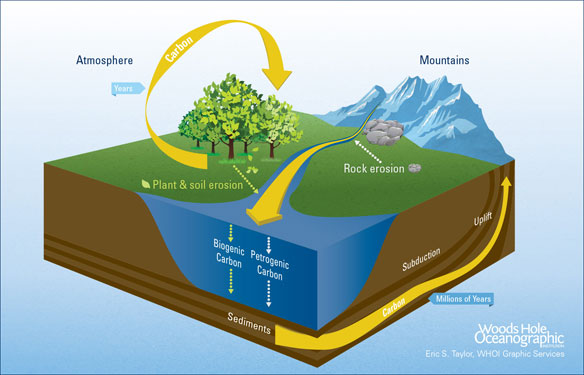
Carbon is a building block for all life and plays a key role in regulating Earth’s climate. It shuttles throughout the planet in two major cycles.(Illustration by Eric S. Taylor/Woods Hole Oceanographic Institution Graphics Services). Captions and Image Source: © Woods Hole Oceanographic Institution
Excerpts;
In a sense, rivers are like airport terminals connecting air, mountains, rocks, plants, soil, and the ocean. And like travelers in airports, the materials transported by rivers can tell stories of where they’ve been, what’s happened to them, and where they’re going.
Each day from July to October, monsoon rains bring the equivalent of 35,000 dump truck loads of dirt racing down the Ganges and Brahmaputra Rivers—50 metric tons per second—and deliver it to the Bay of Bengal off the coast of Bangladesh. Swirling in that debris are tiny pieces of the Tibetan Plateau, bits of leaves that fell in India, and remnants of ancient rocks thrust up by tectonic forces to form the highest reaches of the Himalayas.
Rivers slowly gather all that material, whether born of volcano or by tree, and return it to the sea. Throughout Earth’s history, as its continents and climate have shifted, so has the nature of the material passing through the rivers.
In a sense, rivers are like airport terminals connecting air, mountains, rocks, plants, soil, and the ocean. And like travelers in airports, the materials transported by rivers can tell stories of where they’ve been, what’s happened to them, and where they’re going.
Our lab group endeavors to reveal these stories. We study the sources of materials exported by rivers and analyze how they change over time. We piece together these data to understand two intersecting planetary cycles—one controlled by geology and the other by biology—that span time and space and shape the Earth and life on it.
By parsing these biospheric and geologic cycles, we can begin to reconstruct how the turning of these wheels can shift Earth’s climate—and vice versa.
And all of this is hidden in the 50 metric tons of material flowing every second down the Ganges and Brahmaputra Rivers…
Read Full Article, Woods Hole Oceanographic Institution
Dams – Cutting Off Beach Sand; By Gary Griggs (12-19-2014)
Let’s Talk About Sand: Denis Delestrac At TEDxBarcelona
Denis Delestrac latest feature documentary, “Sand Wars” takes the audience around the globe to unveil a new gold rush and a disturbing fact: we are running out of sand! In this TEDxBarcelona talk, he explains us where sand comes from and where it ends up…









